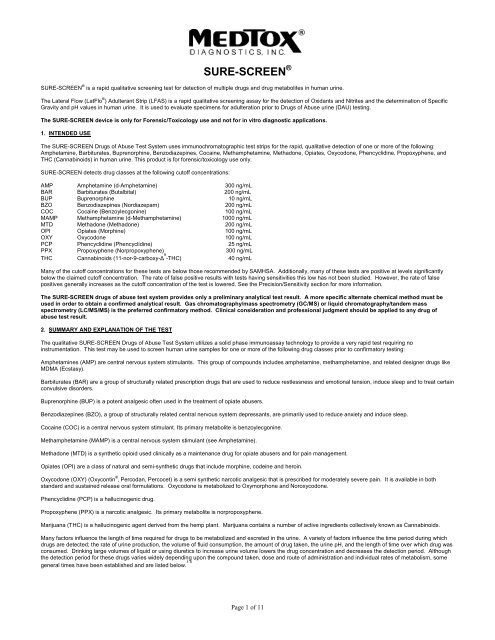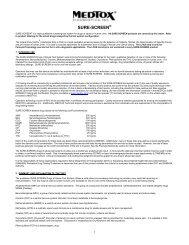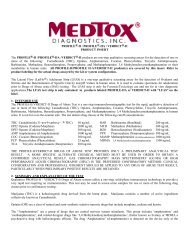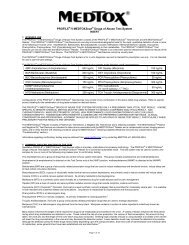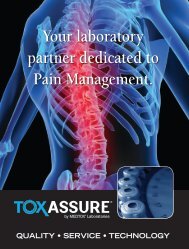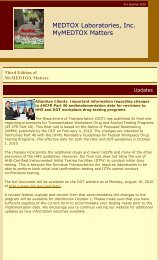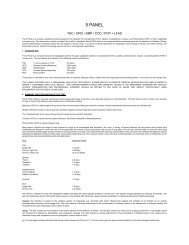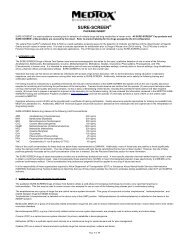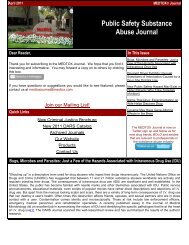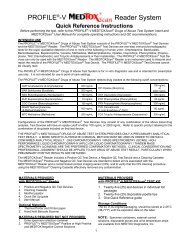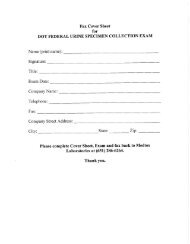92 Frequently Asked Questions on the New 510(K) Paradigm - Medtox
92 Frequently Asked Questions on the New 510(K) Paradigm - Medtox
92 Frequently Asked Questions on the New 510(K) Paradigm - Medtox
You also want an ePaper? Increase the reach of your titles
YUMPU automatically turns print PDFs into web optimized ePapers that Google loves.
SURE-SCREEN ®SURE-SCREEN ® is a rapid qualitative screening test for detecti<strong>on</strong> of multiple drugs and drug metabolites in human urine.The Lateral Flow (LatFlo ® ) Adulterant Strip (LFAS) is a rapid qualitative screening assay for <strong>the</strong> detecti<strong>on</strong> of Oxidants and Nitrites and <strong>the</strong> determinati<strong>on</strong> of SpecificGravity and pH values in human urine. It is used to evaluate specimens for adulterati<strong>on</strong> prior to Drugs of Abuse urine (DAU) testing.The SURE-SCREEN device is <strong>on</strong>ly for Forensic/Toxicology use and not for in vitro diagnostic applicati<strong>on</strong>s.1. INTENDED USEThe SURE-SCREEN Drugs of Abuse Test System uses immunochromatographic test strips for <strong>the</strong> rapid, qualitative detecti<strong>on</strong> of <strong>on</strong>e or more of <strong>the</strong> following:Amphetamine, Barbiturates, Buprenorphine, Benzodiazepines, Cocaine, Methamphetamine, Methad<strong>on</strong>e, Opiates, Oxycod<strong>on</strong>e, Phencyclidine, Propoxyphene, andTHC (Cannabinoids) in human urine. This product is for forensic/toxicology use <strong>on</strong>ly.SURE-SCREEN detects drug classes at <strong>the</strong> following cutoff c<strong>on</strong>centrati<strong>on</strong>s:AMP Amphetamine (d-Amphetamine) 300 ng/mLBAR Barbiturates (Butalbital) 200 ng/mLBUP Buprenorphine 10 ng/mLBZO Benzodiazepines (Nordiazepam) 200 ng/mLCOC Cocaine (Benzoylecg<strong>on</strong>ine) 100 ng/mLMAMP Methamphetamine (d-Methamphetamine) 1000 ng/mLMTD Methad<strong>on</strong>e (Methad<strong>on</strong>e) 200 ng/mLOPI Opiates (Morphine) 100 ng/mLOXY Oxycod<strong>on</strong>e 100 ng/mLPCP Phencyclidine (Phencyclidine) 25 ng/mLPPX Propoxyphene (Norpropoxyphene) 300 ng/mLTHC Cannabinoids (11-nor-9-carboxy-Δ 9 -THC) 40 ng/mLMany of <strong>the</strong> cutoff c<strong>on</strong>centrati<strong>on</strong>s for <strong>the</strong>se tests are below those recommended by SAMHSA. Additi<strong>on</strong>ally, many of <strong>the</strong>se tests are positive at levels significantlybelow <strong>the</strong> claimed cutoff c<strong>on</strong>centrati<strong>on</strong>. The rate of false positive results with tests having sensitivities this low has not been studied. However, <strong>the</strong> rate of falsepositives generally increases as <strong>the</strong> cutoff c<strong>on</strong>centrati<strong>on</strong> of <strong>the</strong> test is lowered. See <strong>the</strong> Precisi<strong>on</strong>/Sensitivity secti<strong>on</strong> for more informati<strong>on</strong>.The SURE-SCREEN drugs of abuse test system provides <strong>on</strong>ly a preliminary analytical test result. A more specific alternate chemical method must beused in order to obtain a c<strong>on</strong>firmed analytical result. Gas chromatography/mass spectrometry (GC/MS) or liquid chromatography/tandem massspectrometry (LC/MS/MS) is <strong>the</strong> preferred c<strong>on</strong>firmatory method. Clinical c<strong>on</strong>siderati<strong>on</strong> and professi<strong>on</strong>al judgment should be applied to any drug ofabuse test result.2. SUMMARY AND EXPLANATION OF THE TESTThe qualitative SURE-SCREEN Drugs of Abuse Test System utilizes a solid phase immunoassay technology to provide a very rapid test requiring noinstrumentati<strong>on</strong>. This test may be used to screen human urine samples for <strong>on</strong>e or more of <strong>the</strong> following drug classes prior to c<strong>on</strong>firmatory testing:Amphetamines (AMP) are central nervous system stimulants. This group of compounds includes amphetamine, methamphetamine, and related designer drugs likeMDMA (Ecstasy).Barbiturates (BAR) are a group of structurally related prescripti<strong>on</strong> drugs that are used to reduce restlessness and emoti<strong>on</strong>al tensi<strong>on</strong>, induce sleep and to treat certainc<strong>on</strong>vulsive disorders.Buprenorphine (BUP) is a potent analgesic often used in <strong>the</strong> treatment of opiate abusers.Benzodiazepines (BZO), a group of structurally related central nervous system depressants, are primarily used to reduce anxiety and induce sleep.Cocaine (COC) is a central nervous system stimulant. Its primary metabolite is benzoylecg<strong>on</strong>ine.Methamphetamine (MAMP) is a central nervous system stimulant (see Amphetamine).Methad<strong>on</strong>e (MTD) is a syn<strong>the</strong>tic opioid used clinically as a maintenance drug for opiate abusers and for pain management.Opiates (OPI) are a class of natural and semi-syn<strong>the</strong>tic drugs that include morphine, codeine and heroin.Oxycod<strong>on</strong>e (OXY) (Oxyc<strong>on</strong>tin ® , Percodan, Percocet) is a semi syn<strong>the</strong>tic narcotic analgesic that is prescribed for moderately severe pain. It is available in bothstandard and sustained release oral formulati<strong>on</strong>s. Oxycod<strong>on</strong>e is metabolized to Oxymorph<strong>on</strong>e and Noroxycod<strong>on</strong>e.Phencyclidine (PCP) is a hallucinogenic drug.Propoxyphene (PPX) is a narcotic analgesic. Its primary metabolite is norpropoxyphene.Marijuana (THC) is a hallucinogenic agent derived from <strong>the</strong> hemp plant. Marijuana c<strong>on</strong>tains a number of active ingredients collectively known as Cannabinoids.Many factors influence <strong>the</strong> length of time required for drugs to be metabolized and excreted in <strong>the</strong> urine. A variety of factors influence <strong>the</strong> time period during whichdrugs are detected; <strong>the</strong> rate of urine producti<strong>on</strong>, <strong>the</strong> volume of fluid c<strong>on</strong>sumpti<strong>on</strong>, <strong>the</strong> amount of drug taken, <strong>the</strong> urine pH, and <strong>the</strong> length of time over which drug wasc<strong>on</strong>sumed. Drinking large volumes of liquid or using diuretics to increase urine volume lowers <strong>the</strong> drug c<strong>on</strong>centrati<strong>on</strong> and decreases <strong>the</strong> detecti<strong>on</strong> period. Although<strong>the</strong> detecti<strong>on</strong> period for <strong>the</strong>se drugs varies widely depending up<strong>on</strong> <strong>the</strong> compound taken, dose and route of administrati<strong>on</strong> and individual rates of metabolism, somegeneral times have been established and are listed below. 1-5Page 1 of 11
DrugDetecti<strong>on</strong> Period Detecti<strong>on</strong> Period Drug Detecti<strong>on</strong> PeriodAmphetamineAcid C<strong>on</strong>diti<strong>on</strong>sAlkaline C<strong>on</strong>diti<strong>on</strong>BarbituratesShort-ActingL<strong>on</strong>g-Acting1-3 days3-10 daysup to 6 daysup to 16 days1-3 daysOpiatesHeroinMorphineCodeineOxycod<strong>on</strong>e1 day1-3 days1-3 days1-3 daysBuprenorphine up to 3 days PCPSingle Use1-8 daysBenzodiazepines 1-12 days Chr<strong>on</strong>ic Use up to 4 weeksCocaine Metaboliteup to 5 days1-3 days typical1-3 daysPropoxypheneup to 1 weekMethad<strong>on</strong>e 1-3 days THCMethamphetamineAcid C<strong>on</strong>diti<strong>on</strong>sAlkaline C<strong>on</strong>diti<strong>on</strong>s1-3 days3-10 daysSingle UseChr<strong>on</strong>ic Use1-7 daysLess than 30 days typicalThe LFAS is a lateral flow strip with impregnated reagent test pads that detect specific analytes in human urine. The specific analytes detected are Oxidants andNitrites. The strip also approximates specific gravity and pH values. The temperature strips <strong>on</strong> <strong>the</strong> cup may be used to detect potential adulterati<strong>on</strong> of <strong>the</strong> sample.Urine samples with “abnormal values” should be submitted to a reference laboratory for additi<strong>on</strong>al testing.Oxidants The detecti<strong>on</strong> is based <strong>on</strong> <strong>the</strong> oxidative activity of compounds (e.g. chromate salts and/or bleach) that catalyze <strong>the</strong> oxidati<strong>on</strong> of an indicator by an organichydroperoxide producing a blue/orange color. The color intensity is directly proporti<strong>on</strong>al to <strong>the</strong> c<strong>on</strong>centrati<strong>on</strong> of oxidants present in <strong>the</strong> sample and is observedvisually and compared to <strong>the</strong> color comparator chart to obtain a result.Nitrites The test is based <strong>on</strong> <strong>the</strong> principles of <strong>the</strong> Griess reacti<strong>on</strong> for <strong>the</strong> detecti<strong>on</strong> of Nitrites. The test paper c<strong>on</strong>tains an amine and a coupling comp<strong>on</strong>ent. Ared/orange colored azo compound is obtained by diazotizati<strong>on</strong> and subsequent coupling. The color intensity is directly proporti<strong>on</strong>al to <strong>the</strong> c<strong>on</strong>centrati<strong>on</strong> of nitritespresent in <strong>the</strong> sample and is observed visually and compared to <strong>the</strong> color comparator chart to obtain a result.pH The test paper c<strong>on</strong>tains indicators that change colors between pH 2 and pH 11. The color scale gives an approximate indicati<strong>on</strong> for pH values between thoselevels.Specific Gravity The test paper reacts with i<strong>on</strong>s in urine to indicate c<strong>on</strong>centrati<strong>on</strong>s from 1.000 to 1.020. The color changes range from dark green with low i<strong>on</strong>icc<strong>on</strong>centrati<strong>on</strong>s through green to yellow/orange in urines with high i<strong>on</strong>ic c<strong>on</strong>centrati<strong>on</strong>s. The color is observed visually and compared to <strong>the</strong> color comparator chart toobtain an approximate result.3. PRINCIPLES OF THE PROCEDUREThe SURE-SCREEN Drugs of Abuse Test System c<strong>on</strong>tains a device with rapid, competitive, membrane-based immunochromatographic test strips, a cup and a lid.A single urine sample can be evaluated for <strong>the</strong> presence of each of <strong>the</strong> specified classes of drugs in a single device. Each test strip c<strong>on</strong>tains antibody colloidal gold,a drug c<strong>on</strong>jugate and a c<strong>on</strong>trol line.ANTIBODY-COLLOIDAL GOLD -- Mouse m<strong>on</strong>ocl<strong>on</strong>al antibodies were developed specifically targeted to <strong>the</strong> drugs listed in <strong>the</strong> Intended Use secti<strong>on</strong>. Eachantibody <strong>on</strong>ly binds drugs from <strong>the</strong> tested drug classes. Antibody-colloidal gold soluti<strong>on</strong>s were prepared by absorbing each of <strong>the</strong> individual m<strong>on</strong>ocl<strong>on</strong>al antibodiesto colloidal gold. The colloidal gold soluti<strong>on</strong>s were applied to <strong>the</strong> sample well pads <strong>on</strong> <strong>the</strong> test strip.DRUG-CONJUGATES -- Drug from each tested class was individually c<strong>on</strong>jugated to protein and immobilized as a line <strong>on</strong> a membrane at <strong>the</strong> locati<strong>on</strong> labeled “T” <strong>on</strong><strong>the</strong> device.CONTROL LINE -- Each test strip has anti-mouse immunoglobulin antibodies immobilized as a line <strong>on</strong> <strong>the</strong> membrane at <strong>the</strong> locati<strong>on</strong> labeled “C” <strong>on</strong> <strong>the</strong> device. Theanti-mouse immunoglobulin antibodies bind <strong>the</strong> mouse antibodies coated <strong>on</strong> <strong>the</strong> colloidal gold.Drugs in <strong>the</strong> urine and <strong>the</strong> drugs c<strong>on</strong>jugated to <strong>the</strong> protein compete to bind to <strong>the</strong> antibody-colloidal gold. When <strong>the</strong> test system cup is tipped over or <strong>the</strong> dip deviceis dipped, urine flows into <strong>the</strong> sample pads of <strong>the</strong> device, <strong>the</strong> dried antibody-colloidal gold <strong>on</strong> <strong>the</strong> sample pad dissolves and <strong>the</strong> urine wicks up <strong>the</strong> white test stripscarrying <strong>the</strong> reddish-purple antibody-colloidal gold with it.Negative SamplesWhen no drug(s) is present in <strong>the</strong> urine sample, <strong>the</strong> red antibody-colloidal gold migrates up <strong>the</strong> test strip and binds to <strong>the</strong> drug c<strong>on</strong>jugate immobilized <strong>on</strong> <strong>the</strong>membrane. The binding of <strong>the</strong> antibody-colloidal gold to <strong>the</strong> drug c<strong>on</strong>jugate generates an easily visible reddish-purple line at <strong>the</strong> “T” locati<strong>on</strong> <strong>on</strong> <strong>the</strong> device. Stripswith two tests will be labeled with two colors and are <strong>on</strong> left-hand side of device. The top color will indicate <strong>the</strong> T1 test with T1= drug test name. The bottom colorwill indicate <strong>the</strong> T2 test with T2= drug test name. Strips with <strong>on</strong>ly <strong>on</strong>e color will have test results appear at <strong>the</strong> T1 positi<strong>on</strong>. Negative results can be reported as so<strong>on</strong>as a line is visible.N<strong>on</strong>-Negative SamplesWhen a drug is present in <strong>the</strong> sample <strong>the</strong> antibody-colloidal gold binds <strong>the</strong> drug before it migrates up <strong>the</strong> test strip. However, when <strong>the</strong> antibody-colloidal gold binds<strong>the</strong> drug in <strong>the</strong> urine, <strong>the</strong> antibody-colloidal gold cannot bind to <strong>the</strong> drug c<strong>on</strong>jugate immobilized <strong>on</strong> <strong>the</strong> test strip. When <strong>the</strong> drug c<strong>on</strong>centrati<strong>on</strong> is at or above <strong>the</strong>cutoff c<strong>on</strong>centrati<strong>on</strong>, <strong>the</strong> majority of <strong>the</strong> antibody colloidal gold is bound to <strong>the</strong> drug from <strong>the</strong> urine. Therefore, as drug bound antibody-colloidal gold migrates up <strong>the</strong>test strip, it is unable to bind to <strong>the</strong> drug c<strong>on</strong>jugate immobilized <strong>on</strong> <strong>the</strong> membrane. Therefore no line is generated at <strong>the</strong> “T” locati<strong>on</strong> <strong>on</strong> <strong>the</strong> device for a n<strong>on</strong>-negativesample. Read n<strong>on</strong>-negative results at 5 minutes.C<strong>on</strong>trol LineEach test strip has an internal procedural c<strong>on</strong>trol. A line must form at <strong>the</strong> c<strong>on</strong>trol “C” locati<strong>on</strong> <strong>on</strong> <strong>the</strong> device to indicate that <strong>the</strong> reagents are migrating properly. If ac<strong>on</strong>trol line does not form, <strong>the</strong> test is c<strong>on</strong>sidered invalid. A c<strong>on</strong>trol line forms when <strong>the</strong> antibody-colloidal gold binds to <strong>the</strong> anti-mouse immunoglobulin antibodyimmobilized <strong>on</strong> <strong>the</strong> membrane as a line at <strong>the</strong> “C” locati<strong>on</strong> <strong>on</strong> <strong>the</strong> device.Page 2 of 11
4. MATERIALS PROVIDED/STORAGE CONDITIONSEach SURE-SCREEN Drugs of Abuse Test c<strong>on</strong>tains all <strong>the</strong> reagents necessary to test <strong>on</strong>e urine sample for <strong>on</strong>e or more drugs simultaneously. SURE-SCREEN testdevices are available in Cup or Dip format as described below.Kit C<strong>on</strong>tents – Cup Test formatThe SURE-SCREEN Drugs of Abuse Cup Test kit c<strong>on</strong>tains twenty-five (25) test system bags and <strong>on</strong>e reference guide.Each Cup Test system bag c<strong>on</strong>tains:1. One (1) test device in a foil package.1. Each test device has test strips with drug specific reagents.2. The test device may c<strong>on</strong>tain a membrane strip laminated with Adulterant test pads for testing <strong>the</strong> presence of Oxidants and Nitrites, as well asdetermining approximate values of Specific Gravity and pH in human urine. (Products with LFAS test strip <strong>on</strong>ly; <strong>the</strong> LFAS test strip is notc<strong>on</strong>tained in every SURE-SCREEN product.)2. One (1) cup with temperature strip attached.3. One (1) lid.4. One (1) security seal.5. One (1) Color Comparator Chart (products with LFAS test strip <strong>on</strong>ly).Kit C<strong>on</strong>tents – Dip Test formatThe SURE-SCREEN Drugs of Abuse Dip Test Kit c<strong>on</strong>tains twenty-five (25) test devices in foil packages and <strong>on</strong>e reference guide.Each Dip Test device has test strips with drug specific reagents.Materials Required but not providedTimerA urine collecti<strong>on</strong> c<strong>on</strong>tainer is not provided with <strong>the</strong> Dip device.Specimen c<strong>on</strong>tainers, disposable gloves and urine temperature strips are available from MEDTOX Diagnostics, Inc.Storage C<strong>on</strong>diti<strong>on</strong>sThe kit, in its original packaging, should be stored at 2-25°C (36-77°F) until <strong>the</strong> expirati<strong>on</strong> date <strong>on</strong> <strong>the</strong> label.5. PRECAUTIONS1. Urine specimens and all materials coming in c<strong>on</strong>tact with <strong>the</strong>m should be handled and disposed of as if infectious and capable of transmitting infecti<strong>on</strong>. Avoidc<strong>on</strong>tact with broken skin.2. Avoid cross-c<strong>on</strong>taminati<strong>on</strong> of urine samples by using a new urine specimen c<strong>on</strong>tainer for each urine sample.3. The device should remain in its original sealed foil pouch until ready to use. If <strong>the</strong> pouch is damaged, do not use <strong>the</strong> test.4. Do not store <strong>the</strong> test kit at temperatures above 25°C (77°F).5. If devices have been stored refrigerated, bring to ambient temperature (18-25°C/ 64-77°F) prior to opening foil pouch.6. Do not use tests after <strong>the</strong> expirati<strong>on</strong> date printed <strong>on</strong> <strong>the</strong> package label.7. The drug screen and <strong>the</strong> LFAS strip are for Forensic/Toxicology use <strong>on</strong>ly.6. SAMPLE COLLECTION AND PREPARATIONFor a Cup Test, collect <strong>the</strong> urine sample in <strong>the</strong> provided cup. The urine volume should be between <strong>the</strong> minimum and maximum volume lines.For a Dip Test, collect <strong>the</strong> urine sample in a clean specimen c<strong>on</strong>tainer.Collecti<strong>on</strong> of 45 mL of urine is more than sufficient for testing. No preservatives should be added. Urine may be tested immediately following collecti<strong>on</strong>. If it isnecessary to store <strong>the</strong> urine, store under refrigerati<strong>on</strong> at 2 to 8°C (36 to 46°F) for no more than two days. Urine may be frozen at -20°C (-4°F) or colder for storage.Stored urine must be brought to ambient temperature (18 to 25°C/64 to 77°F) and mixed well to assure a homogeneous sample prior to testing.7. TEST PROCEDURECup Test1. Bring pouched device to room temperature before opening it. Fill urine sample cup between <strong>the</strong> minimum and maximum volume lines.2. Screw lid clockwise <strong>on</strong>to <strong>the</strong> cup until very tight.3. Open pouch and label <strong>the</strong> device with <strong>the</strong> patient or sample identificati<strong>on</strong>.4. C<strong>on</strong>nect device to lid securely as follows: Hold cup with raised sample port toward you. Hold device cassette with MEDTOX labeled end to your left.Place device cassette <strong>on</strong> top of cup lid with holes aligned. Rotate <strong>the</strong> device clockwise ¼ turn until it snaps in place.5. Tip <strong>the</strong> cup <strong>on</strong> its side to start flow (if less than 45 ml of urine, tilt <strong>the</strong> cup forward to begin flow).6. If LFAS is present, read pH, Specific Gravity, and Nitrites in vertical positi<strong>on</strong> as so<strong>on</strong> as color changes. Read oxidant at 60 sec<strong>on</strong>ds.7. Allow <strong>the</strong> test cup to sit <strong>on</strong> its side for 5 minutes.8. Turn <strong>the</strong> test cup upright and read <strong>the</strong> results. C<strong>on</strong>trol line must be present to read results. Negative results can be read as so<strong>on</strong> as a test line is visible,n<strong>on</strong>-negatives at 5 minutes.Dip Test1. Bring pouched device to room temperature before opening it.2. Open <strong>on</strong>e pouch for each sample to be tested. Write patient or sample identificati<strong>on</strong> informati<strong>on</strong> <strong>on</strong> <strong>the</strong> device.3. Pull off <strong>the</strong> clear cover to expose <strong>the</strong> fiber pads at ends of test strips.4. Dip <strong>the</strong> small end of <strong>the</strong> cassette into <strong>the</strong> sample so that <strong>on</strong>ly <strong>the</strong> white ends of <strong>the</strong> test strips are submerged.5. Hold <strong>the</strong> ends of <strong>the</strong> test strips in <strong>the</strong> sample until <strong>the</strong> reddish-purple soluti<strong>on</strong> begins to run up all of <strong>the</strong> strips.6. Remove <strong>the</strong> device from sample and replace <strong>the</strong> cover to protect <strong>the</strong> wet ends of <strong>the</strong> test strips.7. Lay cassette flat, face up for 5 minutes.8. Read <strong>the</strong> results. C<strong>on</strong>trol line must be present to read results. Negative results can be read as so<strong>on</strong> as a test line is visible, n<strong>on</strong>-negative at 5 minutes.NOTE: Read results at 5 minutes or within 15 minutes of <strong>the</strong> sample applicati<strong>on</strong>. Oxycod<strong>on</strong>e should be read at 5 minutes. Test results interpreted after 15minutes (for Oxycod<strong>on</strong>e after 5 minutes) may not be c<strong>on</strong>sistent with <strong>the</strong> original results obtained at 5 minutes.8. READING THE TEST RESULTSNegative:N<strong>on</strong>-Negative:Invalid:The appearance of a reddish purple line at both <strong>the</strong> c<strong>on</strong>trol area (C) and appropriate test area (T) indicates a negative test result. The colorintensities of <strong>the</strong> c<strong>on</strong>trol lines (C) and test lines (T) may not be equal and may vary from test to test. The test line and c<strong>on</strong>trol line positi<strong>on</strong>smay vary slightly from test strip to test strip. Any line of reddish-purple color, even of faint intensity, indicates a negative test result.The appearance of a c<strong>on</strong>trol line and <strong>the</strong> absence of a test line indicate a preliminary positive test result for that drug.The c<strong>on</strong>trol line must be present for <strong>the</strong> test to be valid. The absence of a c<strong>on</strong>trol line indicates <strong>the</strong> test is invalid. The urine sample shouldbe retested <strong>on</strong> a new device.Page 3 of 11
Examples of Negative, N<strong>on</strong>-Negative and Invalid results:Two test One test Two test One test Two test One testCT1T2CT1T2CT1T2NegativeT2 + T1 +N<strong>on</strong>-NegativeINVALIDThere are o<strong>the</strong>r possible results depending <strong>on</strong> <strong>the</strong> drug or combinati<strong>on</strong> of drugs present in <strong>the</strong> urine sample.9. INTERPRETATION OF TEST RESULTSA NEGATIVE test result for a specific drug indicates that <strong>the</strong> sample does not c<strong>on</strong>tain <strong>the</strong> drug/drug metabolite above <strong>the</strong> cutoff level.A NON-NEGATIVE test result for a specific drug indicates that <strong>the</strong> sample may c<strong>on</strong>tain drug/drug metabolite near or above <strong>the</strong> cutoff level. It does not indicate <strong>the</strong>level of intoxicati<strong>on</strong> or <strong>the</strong> specific c<strong>on</strong>centrati<strong>on</strong> of drug in <strong>the</strong> urine sample. N<strong>on</strong>-negative samples or those with abnormal LFAS tests should be sent to a referencelaboratory for more definitive testing.Understanding <strong>the</strong> Test Results:A n<strong>on</strong>-negative test result does not always mean a pers<strong>on</strong> took illegal drugs and a negative test result does not always mean a pers<strong>on</strong> did not take illegal drugs.There are a number of factors that influence <strong>the</strong> reliability of drug tests. Certain drugs of abuse tests are more accurate than o<strong>the</strong>rs.10. QUALITY CONTROLAn internal procedural c<strong>on</strong>trol is included <strong>on</strong> each test strip. A line must form at <strong>the</strong> c<strong>on</strong>trol (C) positi<strong>on</strong> <strong>on</strong> <strong>the</strong> test strip to indicate that adequate sample volume hasbeen added, <strong>the</strong> reagents migrated properly, and <strong>the</strong> test strip is intact. If a c<strong>on</strong>trol line does not form, <strong>the</strong> test is c<strong>on</strong>sidered invalid. The c<strong>on</strong>trol line c<strong>on</strong>sists ofimmobilized anti-mouse antibody that reacts with <strong>the</strong> antibody-colloidal gold as it passes this regi<strong>on</strong> of <strong>the</strong> membrane. Formati<strong>on</strong> of a visible line verifies <strong>the</strong> c<strong>on</strong>trolline antibody antigen reacti<strong>on</strong> occurred. A visible c<strong>on</strong>trol line should always be present regardless of whe<strong>the</strong>r drug is absent or present in <strong>the</strong> sample. Minimally, aQC program includes external negative and positive c<strong>on</strong>trol material used to m<strong>on</strong>itor <strong>the</strong> performance of each new lot of product, each new shipment of product andmay be used to assess <strong>the</strong> competency of new operators.For additi<strong>on</strong>al informati<strong>on</strong> c<strong>on</strong>cerning QC or forensic testing requirements, c<strong>on</strong>tact <strong>the</strong> appropriate regulatory authority. Users should follow federal, state, and localQC requirements.11. LIMITATIONS OF THE PROCEDURE1. The SURE-SCREEN Drugs of Abuse Test System is <strong>on</strong>ly for use with unadulterated human urine samples.2. There is a possibility that o<strong>the</strong>r substances and/or factors, e.g. technical or procedural errors, may interfere with <strong>the</strong> test and cause false results.LFAS StripThe purpose of <strong>the</strong> adulterati<strong>on</strong> strip is to screen for abnormal c<strong>on</strong>diti<strong>on</strong>s in human urine, such as diluti<strong>on</strong> or <strong>the</strong> additi<strong>on</strong> of drug-test interfering substances.Occasi<strong>on</strong>ally medicati<strong>on</strong>s may discolor <strong>the</strong> urine making it difficult to read <strong>the</strong> result.OxidantNitrites acting as oxidizing agents will produce a blue/green color change <strong>on</strong> <strong>the</strong> Oxidant Pad.NitriteAbnormal results can be caused by <strong>the</strong> presence of diagnostic or <strong>the</strong>rapeutic dyes in <strong>the</strong> urine. Very high c<strong>on</strong>centrati<strong>on</strong>s of oxidant such as 80% bleach will producea brown color change <strong>on</strong> <strong>the</strong> Nitrite pad.12. EXPECTED VALUESSURE-SCREEN TEST SYSTEM:SURE-SCREEN Drugs of Abuse Test System qualitatively detects amphetamine, barbiturates, buprenorphine, benzodiazepines, cocaine, methad<strong>on</strong>e,methamphetamine, opiates, oxycod<strong>on</strong>e, phencyclidine, propoxyphene and THC (Cannabinoids) and/or <strong>the</strong>ir metabolites in human urine at or above <strong>the</strong>ir specifiedcutoff level. Illicit drugs should never be found in urine, and legal drugs (such as amphetamine, barbiturates, buprenorphine, benzodiazepines, methamphetamine,opiates, oxycod<strong>on</strong>e, propoxyphene or methad<strong>on</strong>e) may appear in <strong>the</strong> urine for legitimate reas<strong>on</strong>s. C<strong>on</strong>firmatory test results should be reviewed by a Medical ReviewOfficer for interpretati<strong>on</strong>.LFAS Test:Urines that produce an abnormal result <strong>on</strong> <strong>the</strong> LFAS adulterati<strong>on</strong> strip should be sent to a reference laboratory for more definitive testing to determine if <strong>the</strong> urinemay be dilute, substituted, invalid and/or adulterated.13. PERFORMANCE CHARACTERISTICS13A. Sensitivity, Accuracy, and Precisi<strong>on</strong>AccuracyThe accuracy was evaluated by assaying a panel of blind coded clinical urine samples c<strong>on</strong>taining varying c<strong>on</strong>centrati<strong>on</strong>s of drugs and comparing to GC/MS orLC/MS/MS results. The samples were obtained from MEDTOX Laboratories. Samples were screened at traditi<strong>on</strong>al laboratory cutoff c<strong>on</strong>centrati<strong>on</strong>s by a commercialimmunoassay system. Samples with negative results by both <strong>the</strong> commercial immunoassay system and SURE-SCREEN were not c<strong>on</strong>firmed by GC/MS orLC/MS/MS. Samples with positive results by ei<strong>the</strong>r <strong>the</strong> commercial immunoassay system or SURE-SCREEN were c<strong>on</strong>firmed by GC/MS or LC/MS/MS. Most sampleswere unaltered clinical samples. In order to have samples with c<strong>on</strong>centrati<strong>on</strong>s close to <strong>the</strong> cutoff, some samples were diluted with negative urine. The five minuteresults are shown in <strong>the</strong> following tables. The testing was performed by MEDTOX pers<strong>on</strong>nel.Page 4 of 11
ACCURACY COMPARED TO GC/MS OR LC/MS/MS(Amphetamine, Barbiturates, Buprenorphine, Benzodiazepines, Cocaine, Methamphetamine, Methad<strong>on</strong>e, Opiates, Oxycod<strong>on</strong>e, Phencyclidine,Propoxyphene, and Cannabinoids (THC))5 MinuteNegative by immunoassay; ifpositive, no drug was detectedabove <strong>the</strong> limit of detecti<strong>on</strong> of <strong>the</strong>c<strong>on</strong>firmatory methodC<strong>on</strong>centrati<strong>on</strong> range of upto 50% below <strong>the</strong> cutoff(ng/mL)C<strong>on</strong>centrati<strong>on</strong> rangebetween <strong>the</strong> -50% of<strong>the</strong> cutoff and <strong>the</strong>cutoff (ng/mL)C<strong>on</strong>centrati<strong>on</strong> rangebetween <strong>the</strong> cutoff and50% above <strong>the</strong> cutoff(ng/mL)C<strong>on</strong>centrati<strong>on</strong> range of greaterthan 50% above <strong>the</strong> cutoff(ng/mL)AMP 180 – 255 334 – 402 474 – 11845Positive 0 Not performed 4 4 32Negative 55 Not performed 1 1 1Samples are categorized according to d-amphetamine c<strong>on</strong>centrati<strong>on</strong>s.BAR 109 -194 201 - 298 326 - 27776Positive 0 Not performed 3 12 52Negative 58 Not performed 5 0 0Samples c<strong>on</strong>tained <strong>on</strong>e of <strong>the</strong> following barbiturates: Phenobarbital, Butalbital or Pentobarbital. Ten samples were diluted with negative urine to obtain c<strong>on</strong>centrati<strong>on</strong>s around cutoff.BUP 6-7 13-14 32-50042Positive 0 Not performed 0 4 40Negative 42 Not performed 4 0 0Buprenorphine and Norbuprenorphine added toge<strong>the</strong>r. Six samples were diluted with negative urine to obtain c<strong>on</strong>centrati<strong>on</strong>s around <strong>the</strong> cutoff (2 above, 4 below).BZO 113 - 151 220 - 281 428 - 12491Positive 0 Not performed 4 5 33Negative 54 Not performed 0 0 0Nordiazepam, oxazepam, temazepam, alprazolam and α-hydroxy-alprazolam were added toge<strong>the</strong>r to determine <strong>the</strong> total benzodiazepine c<strong>on</strong>centrati<strong>on</strong> reported in <strong>the</strong> table. Sixsamples were diluted with negative urine to obtain c<strong>on</strong>centrati<strong>on</strong>s around <strong>the</strong> cutoff.COC 55 - 91 110 - 140 153 - 96<str<strong>on</strong>g>92</str<strong>on</strong>g>4Positive 0Not performed6 5 36Negative 54Not performed0 0 0Samples are categorized by benzoylecg<strong>on</strong>ine c<strong>on</strong>centrati<strong>on</strong>s (cocaine metabolite).MTD 112 - 114 249 - 283 307 - 9411Positive 0 Not performed 2 6 44Negative 98 Not performed 2 1 0OPI76 – 90 111 – 147 251 – 136360Positive0 Not performed 4 4 36Negative54 Not performed 0 0 0Morphine, codeine, hydrocod<strong>on</strong>e and hydromorph<strong>on</strong>e were added toge<strong>the</strong>r to determine <strong>the</strong> total opiate c<strong>on</strong>centrati<strong>on</strong>s reported in this table.OXYPositiveNegative11-44 50-98 101-149 156-1641350 5 8 9 12<strong>510</strong>6 11 8 2 3Oxycod<strong>on</strong>e and oxymorph<strong>on</strong>e (weighted as 50%) were added toge<strong>the</strong>r to determine <strong>the</strong> total oxycod<strong>on</strong>e c<strong>on</strong>centrati<strong>on</strong> reported in <strong>the</strong> table.PCP13 - 22 27 - 35 39 - 5439Positive0 Not performed 2 5 33Negative55 Not performed 3 0 0PPXPositiveNegative150-265 339-450 >4720 Not performed 4 6 7360 Not performed 4 1 1Eight samples were diluted with negative urine to obtain c<strong>on</strong>centrati<strong>on</strong>s around <strong>the</strong> cutoff.THC3 21 - 37 42 - 54 62 - 761Positive0 0 5 8 34Negative55 1 1 0 011-nor-9-carboxy-Δ 9 -THC c<strong>on</strong>centrati<strong>on</strong>s are reported in this table.Page 5 of 11
MAMPPositive(1000 ng/mL NegativeGC/MS Methamphetamine (limit of quantitati<strong>on</strong> 50 ng/mL)Positive Negative Total56 0 562 56 5858 56 114Cut-off)TotalOverall agreement >98% (112/114). Samples having discrepant results were analyzed by GC/MS. The false negative samples c<strong>on</strong>tained methamphetamine at 1056 ng/mL and at1136 ng/mL.Sensitivity/Precisi<strong>on</strong>Performance around <strong>the</strong> specific cutoff for each drug was evaluated by testing standard drug soluti<strong>on</strong>s diluted in drug-free urine in triplicate <strong>on</strong> 5 different intervals by 3 in-house operators.Drug-free urine was also tested <strong>on</strong> each interval. The results were interpreted at five minutes.Amphetamine (d-Amphetamine) Cutoff = 300 ng/mLC<strong>on</strong>c. (ng/mL) Number Tested Positive Negative0 540 0 54075 45 0 45150 45 13 32225 45 38 7300 45 44 1375 45 44 1450 45 44 1Barbiturates (Butalbital) Cutoff = 200 ng/mLC<strong>on</strong>c. (ng/mL) Number Tested Positive NegativeNegative 45 0 4550 45 0 4<strong>510</strong>0 45 0 45150 45 12 33200 45 43 2250 45 45 0300 45 45 0Benzodiazepines (Nordiazepam) Cutoff = 200 ng/mLC<strong>on</strong>c. (ng/mL) Number Tested Positive NegativeNegative 540 0 54050 45 30 1<strong>510</strong>0 45 40 5150 45 45 0200 45 45 0250 45 44 1300 45 45 0Cocaine (Benzoylecg<strong>on</strong>ine) Cutoff = 100 ng/mLC<strong>on</strong>c. (ng/mL) Number Tested Positive NegativeNegative 540 0 54025 45 0 4550 45 19 2675 45 25 20100 45 35 10125 45 44 1150 45 41 4Methamphetamine (d-Methamphetamine) Cutoff = 1000 ng/mLC<strong>on</strong>c. (ng/mL) Number Tested Positive Negative0 30 0 30100 30 0 30250 30 0 30500 30 26 4750 30 27 31000 30 28 21250 30 29 11500 30 30 02000 30 30 0Methad<strong>on</strong>e (Methad<strong>on</strong>e) Cutoff = 200 ng/mLC<strong>on</strong>c. (ng/mL) Number Tested Positive NegativeNegative 405 0 40550 45 4 41100 45 37 8150 45 44 1200 45 45 0250 45 44 1300 45 45 0Page 6 of 11
Opiate (Morphine) Cutoff = 100 ng/mLC<strong>on</strong>c. (ng/mL) Number Tested Positive NegativeNegative 540 0 54025 45 20 2550 45 38 775 45 44 1100 45 45 0125 45 44 1150 45 43 2Oxycod<strong>on</strong>e Cutoff = 100 ng/mLC<strong>on</strong>c. (ng/mL) Number Tested Positive NegativeNegative 54 0 5425 54 0 5450 54 4 5075 54 40 14100 54 50 4125 54 53 1150 54 54 0Phencyclidine (Phencyclidine) Cutoff = 25 ng/mLC<strong>on</strong>c. (ng/mL) Number Tested Positive NegativeNegative 540 0 5406.25 45 1 4412.50 45 0 4518.75 45 17 2825.00 45 43 231.25 45 43 237.50 45 44 1Propoxyphene (Norpropoxyphene) Cutoff = 300 ng/mLC<strong>on</strong>c. (ng/mL) Number Tested Positive NegativeNegative 45 0 4530 45 0 4575 45 1 44150 45 9 36225 45 16 29300 45 37 8375 45 42 3450 45 44 1600 45 45 0Cannabinoids (11-nor-9-carboxy-Δ 9 -THC) Cutoff = 40 ng/mLC<strong>on</strong>c. (ng/mL) Number Tested Positive NegativeNegative 105 0 10<strong>510</strong> 45 0 4520 45 0 4530 45 1 4440 45 45 050 45 40 560 45 45 0Cutoff Characterizati<strong>on</strong> (Buprenorphine)Performance around <strong>the</strong> specific cutoff for Buprenorphine was evaluated by testing standard drug soluti<strong>on</strong>s diluted in drug-free urine in triplicate by 10 in-house operators. Drug-free urine wasalso tested by each individual. The results were interpreted at five minutes and shown below:MEDTOX ® Buprenorphine Cutoff Chracterizati<strong>on</strong> ResultsC<strong>on</strong>centrati<strong>on</strong> of sampleNumber of# Positive # Negative(ng/mL)determinati<strong>on</strong>s0 30 0 302.5 30 0 305.0 30 0 307.5 30 9 2110 30 20 1012.5 30 29 115 30 29 113B. N<strong>on</strong> Crossreactive Endogenous CompoundsListed compounds were initially dissolved in appropriate solvents and <strong>the</strong>n added to drug-free urine for evaluati<strong>on</strong> with all SURE-SCREEN tests. Most of <strong>the</strong>compounds were evaluated for reactivity with <strong>the</strong> SURE-SCREEN tests at 100 µg/mL (albumin was evaluated at 20 mg/mL and bilirubin was evaluated at 200μg/mL). Samples were evaluated in triplicate by in-house operators. The listed compounds gave negative results with all of <strong>the</strong> SURE-SCREEN tests.Acetaldehyde Creatinine Hemoglobin, HumanAcet<strong>on</strong>e Epinephrine Sodium ChlorideAlbumin, Human β-Estradiol Tetrahydrocortis<strong>on</strong>eBilirubin Estriol d,1-ThyroxineCholesterol Glucose Std. Soluti<strong>on</strong> Uric AcidPage 7 of 11
13C. Unrelated Compounds, Prescripti<strong>on</strong> and Over-<strong>the</strong>-Counter Medicati<strong>on</strong>sThe following compounds were tested for reactivity to <strong>the</strong> SURE-SCREEN Drugs of Abuse Test System. Listed compounds were dissolved in appropriate solventsand <strong>the</strong>n added to drug-free urine for testing. Samples were evaluated in triplicate by in-house operators. Unless o<strong>the</strong>rwise noted by a drug name abbreviati<strong>on</strong> suchas “AMP” or “BAR” etc., all of <strong>the</strong> listed compounds were negative in each of <strong>the</strong> tests at 100 µg/mL or <strong>the</strong> highest level tested. (Alprazolam, 1-hydroxy;Buprenorphine, Fentanyl, Lorazepam glucur<strong>on</strong>ide, 11-Nor-9-carboxy- 9 -THC, Olanzapine, and Oxazepam glucur<strong>on</strong>ide were evaluated at 10µg/mL. 11-Nor-9-carboxy- 8 -THC was evaluated at 5 µg/mL). If a drug name is followed by an abbreviati<strong>on</strong> such as “AMP” or “BAR” etc., check <strong>the</strong> “Related Compounds and CrossReactants” listing for <strong>the</strong> drug in questi<strong>on</strong> under <strong>the</strong> appropriate heading (AMP, BAR, etc.) to find its level of cross-reactivity to that test.Acecainide (N-Acetaminophen Acetylsalicylic Acid Allobarbital-BAR Alphenal-BAR Alprazolam-BZOAcetylprocainamide)Alprazolam, 1-Hydroxy-BZOp-Aminobenzoic Acid 7-Amino-cl<strong>on</strong>azepam 7-Amino-flunitrazepam Aminoglutethimide l-Aminopyrine (4-(dimethylamino) antipyrine)Amitriptyline Amobarbital-BAR Amoxapine Amoxicillin d-Amphetamine-AMP l- Amphetamine-AMPAmpicillin Apomorphine l-Ascorbic Acid Aspartame Atenolol Atropine SulfateBarbital-BAR Barbituric Acid Benzilic Acid Benzoic Acid Benzocaine (ethyl -4- Benzoylecg<strong>on</strong>ine-COCaminobenzoate)Benzphetamine Benztropine Brompheniramine Buprenorphine-BUP Bupropi<strong>on</strong> Butabarbital-BARButalbital-BAR Caffeine Cannabidiol Cannabinol Captopril CarbamazepineCarbamazepine-10,11 CarisoprodolCephalexin Chloral Hydrate Chloramphenicol Chlordiazepoxide-BZOepoxide(Meprobamate)Chloroquine Chlorothiazide Chlorpheniramine Chlorpromazine Chlorprothixene Clobazam-BZOClomipramine Cl<strong>on</strong>azepam-BZO Cl<strong>on</strong>idine Clorazepate-BZO Clozapine Cocaine-COCCodeine-OPI, OXY Cortis<strong>on</strong>e Cotinine Cyclobenzaprine Cyclopentobarbital-BARDeoxycorticoster<strong>on</strong>eDesalkylflurazepam-BZODesipramineDesmethylchlordiazepoxide (Norchlordiazepoxide)-BZODesmethylflunitrazepam-BZODesmethylvenlafaxineDexamethas<strong>on</strong>eDextromethorphan Diacetylmorphine-OPI Diazepam-BZO Diclofenac Diethylpropi<strong>on</strong> DiflunisalDigoxinDihydrocodeine-OPI, Dimenhydrinate1,3-Dimethylbarbituric acid Diphenhydramine Domperid<strong>on</strong>eOXY(Dramamine)Dopamine Doxepin Doxylamine Ecg<strong>on</strong>ine Ecg<strong>on</strong>ine Methyl Ester EDDP (Primary metabolite ofmethad<strong>on</strong>e)Efavirenz (Sustiva) EMDP (Sec<strong>on</strong>daryEphedrine-MAMP Equilin Erythromycin Estr<strong>on</strong>emetabolite of methad<strong>on</strong>e)-Ethanol Ethylmorphine-OPI, OXY Fenfluramine-MAMP Fenoprofen Fentanyl (Syn<strong>the</strong>tic Flunitrazepam-BZOopiate)Fluoxetine (Prozac) Flurazepam Furosemide Fluvoxamine Gentisic Acid (2,5- GlutethimideDihydroxybenzoic acid)Guaiacol Glyceryl Haloperidol Hexobarbital Hippuric acid Hydralazine HydrochlorothiazideE<strong>the</strong>rHydrocod<strong>on</strong>e-OPI, Hydrocortis<strong>on</strong>eHydromorph<strong>on</strong>e-OPI, Hydroxybupropi<strong>on</strong> Hydroxyhippuric acid l-11-Hydroxy- 9 -THC-THCOXYOXYp-4-Hydroxyphencyclidine- 3-Hydroxytyramine Hydroxyzine Ibuprofen ImipramineHydroxyphenobarbital-BARPCPIpr<strong>on</strong>iazid (R)-Isoproterenol Isoxsuprine Ketamine Ketoprofen LabetalolLevorphanol-OPI Lidocaine Lithium carb<strong>on</strong>ate Loperamide Lorazepam-BZO Lorazepam glucur<strong>on</strong>ide-BZOLoxapine Lysergic Acid-BZO Lysergic AcidMaprotiline MDA-AMP MDE (MDEA)-MAMPDiethylamide (LSD)MDMA-MAMP Melanin Meperidine Mephobarbital Mepivacaine MesoridazineMethad<strong>on</strong>e-MTD d-Methamphetamine- l-Methamphetamine- Methaqual<strong>on</strong>e Methcathin<strong>on</strong>e MethocarbamolMAMPMAMPMethoxyphenamine Methylphenidate Methylpryl<strong>on</strong> Metoprolol Midazolam-BZO Mirtazapine6-M<strong>on</strong>oacetylmorphine-OPIMorphine-OPI, OXYMorphine 3--D-Glucur<strong>on</strong>ide-OPIMorphine 6--D-Glucur<strong>on</strong>ideNalidixic AcidNaltrex<strong>on</strong>e- OXYNalorphine-OPI Nalox<strong>on</strong>e-OPI, OXY Naproxen Niacinamide Nicotine NifedipineNitrazepam-BZO Nitrofurantoin Norclomipramine Norcodeine- OXY Nordiazepam--BZO NordoxepinNorethindr<strong>on</strong>e Norlysergic Acid Normeperidine Norpropoxyphene-PPX l-Norpseudoephedrine 11-Nor-9-carboxy- 9 -THC -THC11-Nor-9-carboxy- 8 - Nortriptyline Noscapine Nylidrin Octopamine Ofloxacin- OPITHC-THCOlanzapine (Zyprexa)- Omeprazole Orphenadrine Oxalic Acid Oxaprosin Oxazepam-BZOTCA positive-Anti-PsychoticOxazepamOxolinic Acid Oxycod<strong>on</strong>e-OPI, OXY Oxymetazoline Oxymorph<strong>on</strong>e-OPI, Papaverine hydrochlorideglucur<strong>on</strong>ide-BZOOXYPentazocine Pentobarbital-BAR Perphenazine PhenacetinPhencyclidine-PCP(Acetophenetidin)Phendimetrazine Phenelzine Phenethylamine- MAMP Pheniramine Phenmetrazine Phenobarbital-BARPhenothiazine Phentermine- AMP PhenytoinPhenylbutaz<strong>on</strong>e Phenylephrine-MAMP Phenylpropanolamine(Diphenylhydantoin)-BARPiroxicam Prazosin Prednisol<strong>on</strong>e Prednis<strong>on</strong>e Procaine- MAMP ProcainamideProchlorperazine Promazine Promethazine Propoxyphene-PPX Propranolol ProtriptylinePseudoephedrine Pyrilamine Quetiapine (Seroquel)- Quinidine Ranitidine RiboflavinTCA positive-Anti-PsychoticRifampin Salicylic Acid Secobarbital-BAR Selegiline (Deprenyl) Serot<strong>on</strong>in (5-Sertraline (Zoloft)Hydroxytryptamine)Sildenafil (Viagra) Sulfamethazine Sulindac Talbutal-BAR Temazepam-BZO Temazepam glucur<strong>on</strong>ide-BZOTetracycline 9 -Tetrahydrocannabinol- 8 -Tetrahydrocannabinol- TetrahydrozolineThebaine-OPITHC( 6 -Tetrahydrocannabinol)THCTheophyline Thiamine Thiopental Thioridazine Thiothixene TolbutamidePage 8 of 11
Tolmetin (Tolectin) Trazod<strong>on</strong>e Triamterene Triazolam-BZO Triazolam, 1-hydroxy TrifluoperazineTrimethoprim Trimipramine Tripelennamine Tryptamine Tryptophan TyramineTyrosine Valproic Acid Venlafaxine Verapamil Zomepirac13D. Related and Reactive CompoundsThe following metabolites and reacting compounds were evaluated for <strong>the</strong> specified test <strong>on</strong> <strong>the</strong> SURE-SCREEN Drugs of Abuse Test System. Reference standardsfor <strong>the</strong> various metabolites and compounds were prepared in negative urine samples. Results are expressed as <strong>the</strong> minimum c<strong>on</strong>centrati<strong>on</strong> expected to produce apositive result in <strong>the</strong> indicated assay. Compounds that reacted with <strong>the</strong> test are listed first, and related compounds that did not react with <strong>the</strong> highest c<strong>on</strong>centrati<strong>on</strong>tested are listed sec<strong>on</strong>d as Negative at 100,000 ng/mL (or highest level tested).Amphetamines- (AMP) (d-Amphetamine) 300 ng/mL Result % Cross-Reactivel-Amphetamine Positive at 100,000 ng/mL
7-Aminocl<strong>on</strong>azepam Negative at 100,000 ng/mL N<strong>on</strong>e Detected7-Aminoflunitrazepam Negative at 100,000 ng/mL N<strong>on</strong>e DetectedFlurazepam Negative at 100,000 ng/mL N<strong>on</strong>e DetectedPyrilamine Negative at 100,000 ng/mL N<strong>on</strong>e DetectedSildenafil Negative at 100,000 ng/mL N<strong>on</strong>e DetectedSulindac Negative at 100,000 ng/mlL N<strong>on</strong>e DetectedTriazolam, 1-OH Negative at 100,000 ng/mL N<strong>on</strong>e DetectedCocaine-(COC) (Benzoylecg<strong>on</strong>ine) 100 ng/mL Result % Cross-ReactiveCocaine Positive at 300 ng/mL 33%Ecg<strong>on</strong>ine Negative at 100,000 ng/mL N<strong>on</strong>e DetectedEcg<strong>on</strong>ine Methyl Ester Negative at 100,000 ng/mL N<strong>on</strong>e DetectedMethamphetamine-(MAMP) (dMethamphetamine) Result% Cross-Reactive1000 ng/mLEphedrine Positive at 2,500 ng/mL 40%Fenfluramine Positive at 25,000 ng/mL 4%MDE (MDEA) Positive at 5,000 ng/mL 20%MDMA Positive at 1,500 ng/mL 67%l-Methamphetamine Positive at 7,500 ng/mL 13%Phenethylamine Positive at 5,000 ng/mL 20%Phenylephrine Positive at 50,000 ng/mL
Propoxyphene Positive at 50 ng/mL 600%Cannabinoids-(THC) (11-Nor-9-carboxy- 9 -THC) 40 Result% Cross-Reactiveng/mLL-11-Hydroxy- 9 -THC Positive at 250 ng/mL 16%11-Nor-9-carboxy- 8 -THC Positive at 1,000 ng/mL 4%∆ 9 –Tetrahydrocannabinol Positive at 10,000 ng/mL


